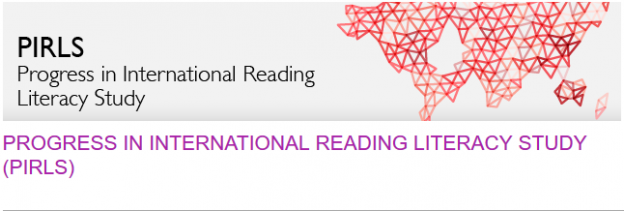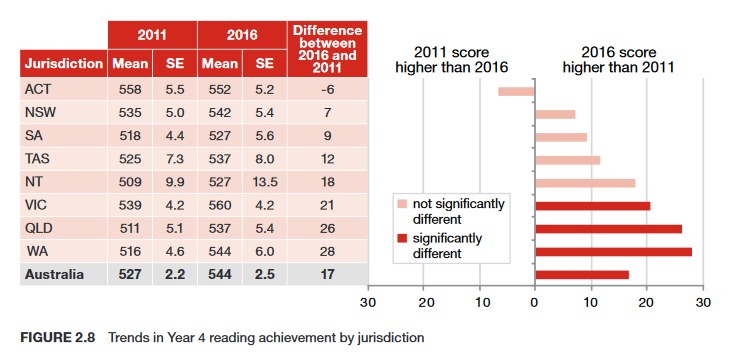PIRLS 2016 results
5 Replies
The 2016 Progress in International Reading Literacy Study (PIRLS) results came out yesterday. They show that Australian Year 4 kids are better at reading than they were in 2011. Excellent.
However, only 81% reached the “proficient” benchmark, and about 7% of kids are still reading very poorly*, a number unchanged since 2011. Far too many of them are indigenous.
What did PIRLS 2016 involve?
One Year 4 class plus all indigenous Year 4 students in 286 schools (6341 kids in total) across the country took part. The school sample was selected to represent all states and territories as well as Australia’s geographic, school sector and socioeconomic diversity.
 From Reporting Australia’s results: PIRLS 2016, on the ACER website, p26.
From Reporting Australia’s results: PIRLS 2016, on the ACER website, p26.
The test examined two different types of reading in 12 different texts:
- Reading for literary experience, and
- Reading for information.
Each student read two texts, and answered questions which assessed their ability to get information (implicit and explicit) from the texts, and interpret, integrate and evaluate them. The kids also completed questionnaires about their backgrounds, characteristics and attitudes to learning and reading. School staff also completed questionnaires.
PIRLS 2016 Benchmarks
International benchmarks for this test were:
- Advanced: 625 points
- High: 550 points
- Intermediate: 475 points
- Low: 400 points.
Australian children’s average PIRLS 2016 score
Aussie kids’ average score was 544 points, which is 17 points higher than in 2011.
Statistical analysis shows that this isn’t a fluke, it’s a real improvement. Please give primary teachers you know a pat on the back for this great result.
Australian kids did better than 24 other participating countries, including three that tested in English (NZ, Malta and Trindad and Tobago). 13 countries did better than Australia, including five that tested in English (Singapore, Hong Kong, Ireland, Northern Ireland and England).
16% of Australian kids reached the Advanced benchmark. 81% reached the Intermediate benchmark, 83% of non-indigenous students but only 53% of indigenous students.

This massive difference is simply disgraceful, a gap we must close.
Aussie kids tended to be better at literary style reading than reading for information. Girls, city kids, kids who spoke English at home and those living in the ACT and Victoria tended to do better on the test, as did those from more affluent areas and those with lots of books (not a lot of surprises there). This graph from p45 of the ACER report shows the trends since the 2011 PIRLS by state:

So a special congratulations to teachers in Western Australia, Queensland and Victoria, which made significant improvements.
Who were the weakest readers?
Around 7% of students did not reach the “Low” benchmark on the PIRLS, the same percentage as in PIRLS 2011*.
These are students with poor decoding, poor language comprehension, or both.
The PIRLS test is not set up to identify which kids have which of these problems, yet that’s what their teams need to know before designing intervention that will be effective.
The PIRLS report fence-sits on diagnosing and intervening for these kids, saying “debate reigns as to what aspects of reading can be improved with targeted interventions and when” (p60).
Well, yes, there’s lots of debate, that’s true, in the same way that there’s a lot of debate about climate science, but that doesn’t mean all the debaters have proper evidence or make much sense. Reading is one of the best-understood of human behaviours, and people who still argue that reading is a psycholinguistic guessing game are talking through their, ehem, hats. Their multi-cueing, rote-learning of high frequency word lists, embedded phonics etc lacks good evidence and needs to stop. Their predictable texts belong in the recycling.
The lowest 7% of kids need their phonemic awareness, real and nonsense word reading, spelling, working memory, rapid automatised naming and receptive language skills assessed, and then to be given well-targeted, intensive intervention based on this assessment. The ones with poor decoding generally need explicit, systematic phonics intervention. The ones with poor listening skills generally need language therapy. The ones with both generally need both.
Too often it’s left to parents to organise and pay for this assessment and intervention, and too often our system says “bad luck” to kids whose parents can’t afford it.
We need a much better answer for these kids, to improve their participation, success and self-esteem, and to make sure we don’t have 7% of kids scoring “Low” on the next PIRLS.
* I notice that Jennifer Buckingham’s article in The Conversation about this topic says that there has been a 1% reduction in children in the “Low” group on the PIRLS in 2016, from 7% to 6%. I got the figure 7% from the ACER report, which on p40 says, “Around 7 per cent of students in Year 4 did not manage to reach the Low benchmark in PIRLS 2016, and this proportion remains unchanged from PIRLS 2011”. However, Jennifer may have had a chance to look at the raw data from both studies and thus drawn a slightly more optimistic conclusion.



I am interested in knowing HOW the information from the accompanying surveys about how many books in the home and other sociological facts are gained. If the children who have no or low reading skills can’t read the survey questions, how can they give that information?
Yes, true, the kids with the lowest skills might not have been able to read the questions. There is a lot of info about the study design here, I haven’t seen anything in it that says someone read out the survey questions, but they might have. https://research.acer.edu.au/cgi/viewcontent.cgi?article=1000&context=pirls
Naturally I read to my kids and even now read to grandkids and encourage a love of books. But the low achievers worry us all. I guess it’s common for people to hear what I hear:
“Don’t give us a whole lot of theory. Just tell us what we have to do to get these kids writing more, and writing better”. Too often we’re talking about boys in this context.
What single things would make most difference to reluctant writers, and reluctant readers? I have my own ideas, but some of you may know more than me!
Peter West, PhD
Australian Catholic University
Hi Peter, most of the reluctant readers and writers that I see are struggling to crack the complex spelling code of English, and thus find encoding/decoding difficult, though their speaking and listening skills are in the average range. They don’t want to pick up a pencil or a book because they make heaps of mistakes, and it’s not fun or very successful, especially once they’re aware that their peers can read and write a lot more and better than they can. They need to do writing and reading tasks that set them up for success not failure, and which systematically help them crack our spelling code, by starting off with tasks and texts that include only short words and spelling patterns they know, and gradually introducing longer words and more patterns till they have covered all the major ones and can start noticing and self-teaching the outliers, because they aren’t lost in a swamp of complexity any more. That’s why synthetic phonics is so effective with such learners, and why all three major national inquiries into teaching reading have recommended its use. But of course this is a generalisation, and for strugglers the key is good assessment of their phonemic awareness, real and pseudoword reading, spelling, memory, naming, listening and speaking skills, in order to target their specific difficulties and not waste time working on things that they already know and can do. Alison
[…] https://www.spelfabet.com.au/2017/12/pirls-2016-results/ […]